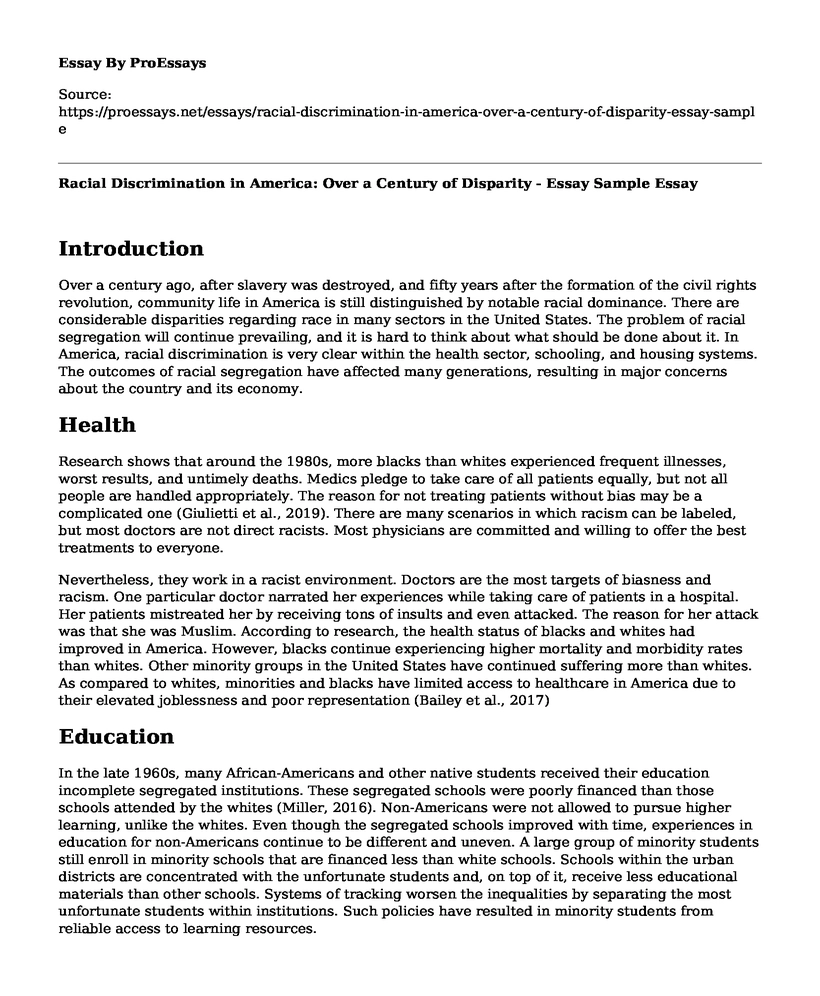Introduction
Over a century ago, after slavery was destroyed, and fifty years after the formation of the civil rights revolution, community life in America is still distinguished by notable racial dominance. There are considerable disparities regarding race in many sectors in the United States. The problem of racial segregation will continue prevailing, and it is hard to think about what should be done about it. In America, racial discrimination is very clear within the health sector, schooling, and housing systems. The outcomes of racial segregation have affected many generations, resulting in major concerns about the country and its economy.
Health
Research shows that around the 1980s, more blacks than whites experienced frequent illnesses, worst results, and untimely deaths. Medics pledge to take care of all patients equally, but not all people are handled appropriately. The reason for not treating patients without bias may be a complicated one (Giulietti et al., 2019). There are many scenarios in which racism can be labeled, but most doctors are not direct racists. Most physicians are committed and willing to offer the best treatments to everyone.
Nevertheless, they work in a racist environment. Doctors are the most targets of biasness and racism. One particular doctor narrated her experiences while taking care of patients in a hospital. Her patients mistreated her by receiving tons of insults and even attacked. The reason for her attack was that she was Muslim. According to research, the health status of blacks and whites had improved in America. However, blacks continue experiencing higher mortality and morbidity rates than whites. Other minority groups in the United States have continued suffering more than whites. As compared to whites, minorities and blacks have limited access to healthcare in America due to their elevated joblessness and poor representation (Bailey et al., 2017)
Education
In the late 1960s, many African-Americans and other native students received their education incomplete segregated institutions. These segregated schools were poorly financed than those schools attended by the whites (Miller, 2016). Non-Americans were not allowed to pursue higher learning, unlike the whites. Even though the segregated schools improved with time, experiences in education for non-Americans continue to be different and uneven. A large group of minority students still enroll in minority schools that are financed less than white schools. Schools within the urban districts are concentrated with the unfortunate students and, on top of it, receive less educational materials than other schools. Systems of tracking worsen the inequalities by separating the most unfortunate students within institutions. Such policies have resulted in minority students from reliable access to learning resources.
Housing
One certain professor in sociology recently discussed the seriousness of housing difficulties for poor Americans. He observed that increased costs of housing and decreasing incomes for the poor mean that unfortunate households use a substantial amount of their wages on paying rent. Long ago, Latinos were not discriminated against in housing like the African-Americans were. After a lot of research was done, it was found out that Latinos and African-Americans were not any different in housing discrimination by the Americans. Recent research shows that to live in particular households, blacks and Latinos had to earn higher than whites. (Goering & Wienk, 2018). Besides, both the blacks and Latinos were discriminated against when they lend money for purchasing houses. The non-Americans have continued paying higher rates of interest than Americans. The endowment of racial and economic segregation in housing is almost intentional. Some policies resulted in discrimination in housing systems.
Conclusion
In conclusion, racial discrimination continues affecting housing, health, and education systems in the United States. Even though a larger percentage has eradicated racism, more scenarios are still present in education, health, and housing. To eliminate racism, people have to appreciate others the way they are and realize that everyone is the same regardless of color or origin.
References
Bailey, Z. D., Krieger, N., Agénor, M., Graves, J., Linos, N., & Bassett, M. T. (2017). Structural racism and health inequities in the USA: evidence and interventions. The Lancet, 389(10077), 1453-1463. https://doi.org/10.1016/S0140-6736(17)30569-X
Giulietti, C., Tonin, M., & Vlassopoulos, M. (2019). Racial discrimination in local public services: A field experiment in the United States. Journal of the European Economic Association, 17(1), 165-204. https://doi.org/10.1093/jeea/jvx045
Goering, J., & Wienk, R. (2018). Mortgage lending, racial discrimination, and federal policy. Routledge. https://doi.org/10.4324/9780429448522
Miller, A. S. (2016). Racial Discrimination and Private Schools. The Catholic Lawyer, 3(2).
Cite this page
Racial Discrimination in America: Over a Century of Disparity - Essay Sample. (2023, Aug 09). Retrieved from https://proessays.net/essays/racial-discrimination-in-america-over-a-century-of-disparity-essay-sample
If you are the original author of this essay and no longer wish to have it published on the ProEssays website, please click below to request its removal:
- Terrorist Attack on the Eagles of Death Metal Concert
- Avoiding Violence Between Police and Citizens - Essay Sample
- Identity Development and Discrimination: Essay Sample
- Combating Islamophobia in Canada: Discrimination, Perspectives and Behaviors - Essay Sample
- Essay on Compulsive Behaviors: Understanding Their Significance in Addiction
- Drug Abuse: Taking Medications for Non-Therapeutic Reasons - Essay Sample
- Essay Example on John's Downward Spiral: Loss of Employment and Social Needs







